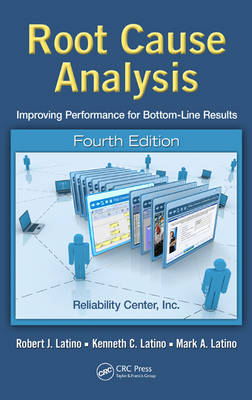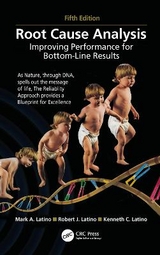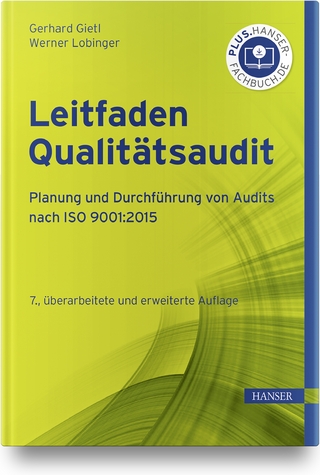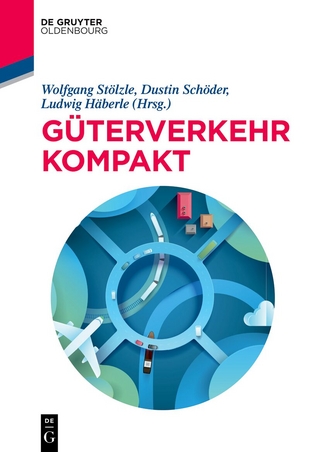
Root Cause Analysis
Crc Press Inc (Verlag)
978-1-4398-5092-3 (ISBN)
- Titel erscheint in neuer Auflage
- Artikel merken
See what’s new in the Fourth Edition:
Human Error Reduction Techniques (HERT) – new chapter
Failure Scene Investigation (FSI) – Disciplined Evidence Gathering
Categorical versus Cause-and-Effect RCA Tools
Analysis Tools Review
The Germination of a Failure
Constructing a Logic Tree
Introduction of PROACTOnDemandSM
The Advantages of Software-as-a-Service (SaaS)
The Pros and Cons of RCA Templates
Three New Client Case Histories
The authors discuss evidence collection and strategy, failure scene investigation techniques, the human element, and the contribution of human performance and human factors to poor decision making. They clarify definitions that can be considered ambiguous and underscore the distinctions between applying PROACT manually using a paper-based system versus using an automated software tool.
Written by practitioners for practitioners, the book outlines an entire RCA system which involves a cultural paradigm change about how failure is perceived and acted upon in an organization. The authors’ trademark, down-to-earth style provides a step-by-step action plan for how to construct and implement a root cause analysis system that can be applied to any industry.
Read MRI Safety 10 Years Later, co-authored by Robert Latino.
Robert J. Latino is the CEO of Reliability Center, Inc., a Reliability Consulting firm in Hopewell, Virginia that specializes in improving Equipment, Process and Human Reliability. Kenneth C. Latino and Mark A. Latino are Presidents at Reliability Center, Inc.
Introduction to the PROACT Root Cause Analysis (RCA) Work Process
Mean Time Between Failure (MTBF)
Frequency of Events
Maintenance Cost
Availability
Reliability
Balanced Scorecard
The RCA Work Process
Introduction to the Field of Root Cause Analysis
What is Root Cause Analysis (RCA)?
Why Do Undesirable Outcomes Occur? The Big Picture
Are All RCA Methodologies Created Equal?
Attempting to Standardize RCA — Is This Good For the Industry?
What is Not Root Cause Analysis?
How to Compare Different RCA Methodologies When Researching Them
What Are the Primary Differences Between Six Sigma and RCA?
Obstacles to Learning from Things That Go Wrong
Creating the Environment for RCA to Succeed: The Reliability Performance Process (TRPP)
The Role of Executive Management in RCA
The Role of a RCA Champion (Sponsor)
The Role of the RCA Driver
Setting Financial Expectations: The Reality of the Return
Institutionalizing Root Cause Analysis (RCA) in the System
Failure Classification
RCA as an Approach
Opportunity Analysis: “The Manual Approach”
Step 1: Perform Preparatory Work
Define the System to Analyze
Define Undesirable Event
Draw Block Diagram (Use the Contact Principle)
Describe the Function of Each Block
Calculate the “Gap”
Develop Preliminary Interview Sheets and Schedule
Step 2: Collect the Data
Step 3: Summarize and Encode Data
Step 4: Calculate Loss
Step 5: Determine the “Significant Few”
Step 6: Validate Results
Step 7: Issue a Report
Asset Performance Management Systems (APMS): Automating the Opportunity Analysis Process
Determining Our Event Data Needs
Establish a Workflow to Collect the Data
Employ a Comprehensive Data Collection System
Analyze the Digital Data
The PROACT® RCA Methodology
Preserving Event Data
The Error-Change Phenomenon
The 5-Ps Concept
Parts
Position
People
Paper
Paradigms
Ordering the Analysis Team
Novices versus Veterans
The RCA Team
Analyzing the Data: Introducing the PROACT Logic Tree
An Academic Example
Confidence Factors
The Troubleshooting Flow Diagram
Communicating Findings and Recommendations
The Recommendation Acceptance Criteria
Developing the Recommendations
Developing the Report
The Final Presentation
Tracking for Bottom-Line Results
Getting Proactive Work Orders Accomplished in a Reactive Environment
Sliding the Proactive Work Scale
Developing Tracking Metrics
Exploiting Successes
Creating a Critical Mass
Recognizing the Life Cycle Effects of RCA on the Organization
Conclusion
Automating Root Cause Analysis: The Utilization of The PROACT Enterprise Version 3.0+
Customizing PROACT For Our Facility
Setting Up a New Analysis in the New PROACT FMEA and OA Module
Setting Up a New Analysis in the New PROACT RCA Module
Automating the Preservation of Event Data
Automating the Analysis Team Structure
Automating the Root Cause Analysis — Logic Tree Development
Automating the RCA Report Writing
Automating Tracking Metrics
Case Histories
Case History #1: ISPAT Inland, Inc. East Chicago, IN
Case History #2: Eastman Chemical Company Kingsport, TN
Case History #3: LYONDELL-CITGO Refining Houston, TX
Case History #4: Eastman Chemical Company World Headquarters Kingsport, TN
Case History #5: Southern Companies Alabama Power Company Parrish, AL
Case History #6: Weyerhauser Company Valliant, OK
Index
| Erscheint lt. Verlag | 14.6.2011 |
|---|---|
| Zusatzinfo | 0-50 equations; 22 Tables, black and white; 131 Illustrations, black and white |
| Verlagsort | Bosa Roca |
| Sprache | englisch |
| Maße | 156 x 235 mm |
| Gewicht | 544 g |
| Themenwelt | Technik ► Maschinenbau |
| Wirtschaft ► Betriebswirtschaft / Management ► Logistik / Produktion | |
| ISBN-10 | 1-4398-5092-5 / 1439850925 |
| ISBN-13 | 978-1-4398-5092-3 / 9781439850923 |
| Zustand | Neuware |
| Informationen gemäß Produktsicherheitsverordnung (GPSR) | |
| Haben Sie eine Frage zum Produkt? |
aus dem Bereich



